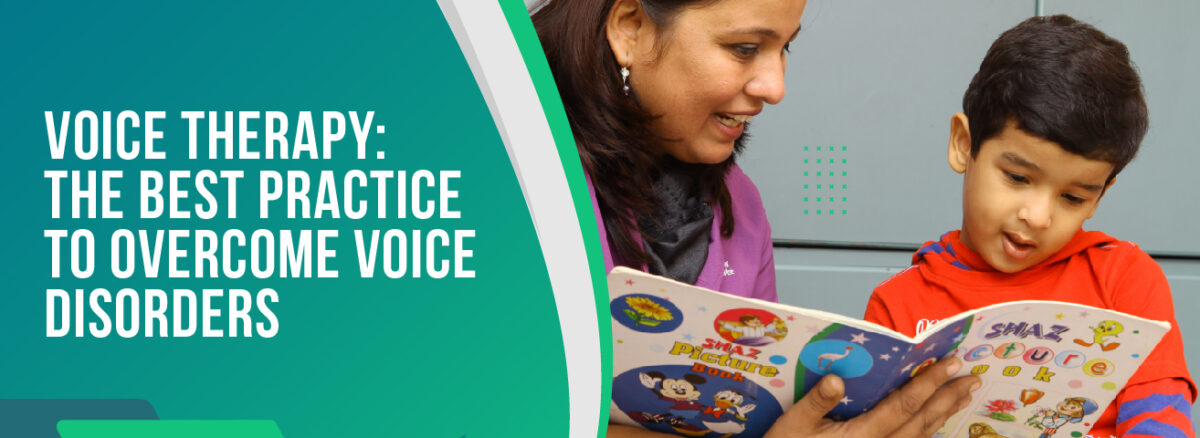- January 20, 2023
- admin
- Comment: 0
- Award Winning, blog, news
Voice Therapy: The Best Practice to Overcome Voice Disorders
Voice therapy is the procedure and techniques that are used in voice disorder treatment that focus on vocal parameters such as vocal closure, volume, pitch, and quality of voice. The primary purpose of voice therapy is to control voice disorders and alter the overall quality of the voice. This therapy is provided by speech-language pathologists, respiratory therapists, and voice coaches, who eliminate and improve problems with the creation of vocal sounds (phonation) in the larynx (voice box). People with voice disorders can change their vocal behaviour and heal their vocal cords with the proper aid of voice therapy.
How Our Voice Work?
When we make sound, air moves from our lungs into the windpipe (trachea) and voice box. Our larynx contains two vocal cords. As air passes through these flexible muscles, vibrations are produced that produce sound waves, which are our voice.Usually, our vocal cords vibrate together to produce a clear sound. Voice disorders occur when our vocal cords vibrate improperly or do not fully open or close.
What is a Voice Disorder?
A “Voice Disorder” is referred to as a persistent change in someone’s voice. It affects our larynx (voice box), which changes your voice either consistently or inconsistently. The larynx is a region of the throat that has the muscles required for breathing, speaking, and swallowing and contains our vocal cords.
Voice disorder is a change in the pitch, loudness, and quality of your voice. People with voice disorders sound husky, weak, and strained; their voice occasionally becomes a whisper or disappears entirely.
A wide variety of factors can lead to voice disorders, which are classified as follows:
- Functional Voice Disorders– These can be caused by speaking loudly and frequently.
- Organic Voice Disorders– These occur due to changes affecting the larynx. Functional voice disorders can also cause physical changes like vocal nodules. Paralysis of the vocal cords is another organic voice disorder that occurs after thyroid surgery.
- Psychogenic Voice Disorder– In these conditions, the voice becomes hoarse, cracked, or completely silent as a result of a traumatic experience or a mental illness like depression.
How Voice Therapy Helps to Overcome Voice Disorder?
In voice therapy, your speech-language pathologist helps you reduce the hoarseness of your voice through guided changes in lifestyle and vocal behaviour. Voice therapy techniques involves a variety of exercises to shape healthy vocal behaviour, reduce harmful vocal behaviour, and help in vocal wound healing after injury.
Voice Therapy Includes the Following Exercises:
- Breathing Exercise: This activity helps in learning how to coordinate speech and breathing by using your diaphragm.
- Relaxation Exercises: It helps in reducing tension.
- Exercise for the Mouth and Jaw Muscles: This exercise targets the mouth and jaw muscles through intentional yawning, sighing, or chewing movements.
- Movement Exercise: It helps to improve your posture.
- Voice Building Exercise: For people with weak vocal cords, this exercise helps to strengthen breath support and vocal cords.
- Semi-Occluded Vocal Tract Sounds: these exercises include lip trills, humming, and straw phonation, which assist healthy vocal cord vibration.
Depending on the cause of voice disorder and individual factors, different kinds of exercises and therapies are found to be suitable for different people. Vocal therapy exercises train the muscles used to swallow and promote the formation of vocal sounds in your mouth and throat.
Who Needs Voice Therapy?
Voice therapy helps children and adults who have these kinds of voice disorders:
- Muscle tension dysphonia– Occurs through excess stress on the vocal cords.
- Laryngitis– It is a swelling of the voice box caused by an upper respiratory infection or allergies.
- Vocal Cord Dysfunction (VCD) – It can lead to trouble breathing during exercise.
- Spasmodic Dysphonia (Vocal Tremor) – It is a neurological disorder, which leads through muscles shake causes periodic breaks in speech.
- Vocal Cord Lesions– It includes nodules, cysts and polyps, which affects your voice through formation of Benign in vocal cords.
- Vocal Cord Paralysis– Due to nerve and scar damage, you’re both the vocal folds lost their moment, known as vocal cord paralysis. It causes difficulty swallowing (dysphagia), shortness of breath (dyspnea), and hoarseness in your voice.
Conclusion
Voice disorders are a very common problem in children and adults, which can be improved by proper voice therapy techniques. The voice therapy exercises guided by a voice therapist eliminate the harmful vocal behavior, heal your vocal cords after injury, and promote healthy vocal behavior.

